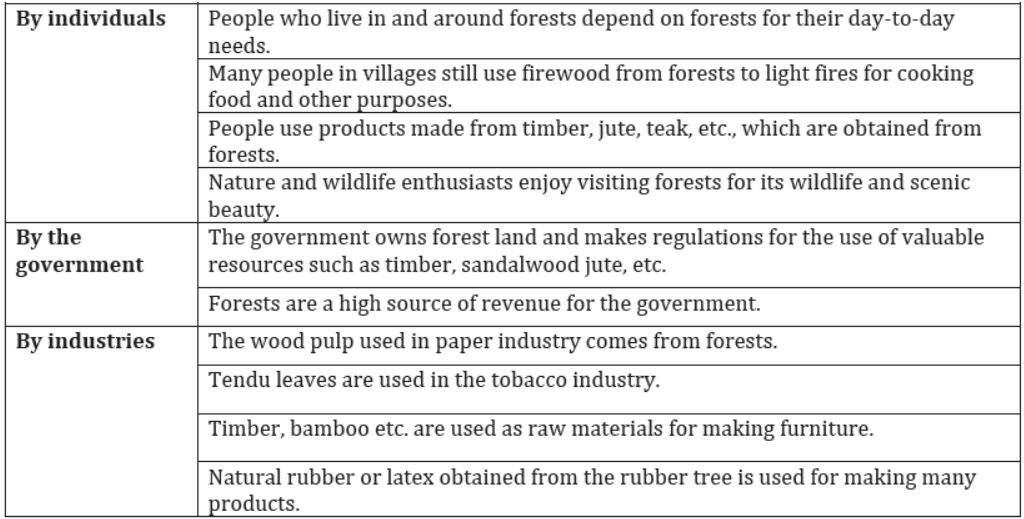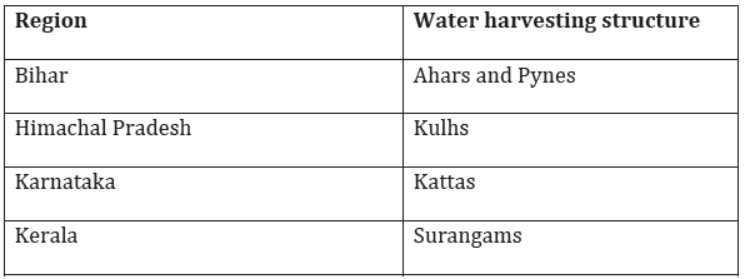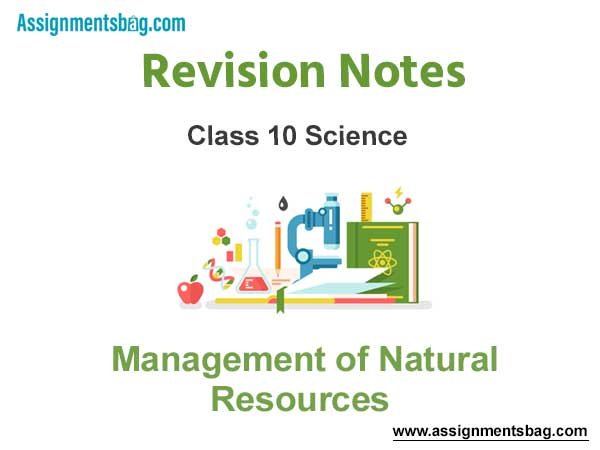Please see Management of Natural Resources Class 10 Science Revision Notes provided below. These revision notes have been prepared as per the latest syllabus and books for Class 10 Science issues by CBSE, NCERT, and KVS. Students should revise these notes for Chapter 16 Management of Natural Resources daily and also prior to examinations for understanding all topics and to get better marks in exams. We have provided Class 10 Science Notes for all chapters on our website.
Chapter 16 Management of Natural Resources Class 10 Science Revision Notes
Need for Management of Natural Resources
We use various natural resources such as forests, wildlife, water, coal, petroleum etc, for our various needs. As the level of development increases, the rate of utilization of these natural resources also increases. A majority of these natural resources is exhaustible. Excessive use of these natural resources causes a negative impact on our environment. It releases pollutants that pollute the air, water, and soil. The use of these natural resources also leads to the degradation of the environment. We therefore need a systematic plan for the utilization and conservation of these natural resources. This is known as natural resource management.
Natural resource management is the optimum utilization of natural resources by maintaining the balance of natural environment for sustainable utilization and development.
Why do we need to manage natural resources?
We need to manage natural resources because of the reasons listed below.
- A majority of natural resources is limited
- Human population is increasing at a tremendous rate
- Utilization of natural resources is increasing at an exponential rate
- Need to conserve resources for future generations
- Equal distribution of resources for equal benefit
- Need to reduce the damage caused to the environment because of the over-exploitation and utilization of resources
- Waste generated from the utilization of these resources is to be safely disposed
Thus, a proper and planned utilization of natural resources is essential for sustainable development.
Sustainable development refers to a balance between natural resources, ecosystems, and the human requirement for resources, for the development and growth in the standards of living. Sustainable development also includes the safeguarding of our natural resources so that they are of use to the future generations.
The following table shows some of the problems arising from the over-exploitation of natural resources.

The over-exploitation of resources and the related environmental problems are global problems. Therefore, there are many national and international laws for the protection of the environment. Several international organisations are also working toward the protection of environmental resources.


In addition to this, every country enforces its own laws and regulations for the protection of the environment. Let us know the objectives of a few of these laws.
One such movement in India is the Ganga Action Plan.
The Ganga is over 2500 km long and passes through the states of Uttarakhand, Uttar Pradesh, Bihar, and West Bengal. The major sources of pollution are garbage, excreta,untreated sewage, bathing, washing, immersion of ashes, and chemical waste from
industries.
The objective of the Ganga Action Plan is to improve the quality of water by preventing pollution. It is a multi-crore action plan to clean up the Ganga.
Do You Know:
About 60000 people bathe in the river Ganga daily, and 1 billion litres of untreated sewage is dumped daily into the river
Natural resources can be conserved by the three-R-method.

A particular method of conservation (reducing consumption, recycling or reusing) is more suitable for a particular natural resource.
For example, Petroleum and coal cannot be reused or recycled. Hence, reducing the consumption of petroleum and diesel is the only way in which these resources can be conserved.

Aluminium products are regularly used for wrapping food items and making soft drink cans etc. After using these products, we usually tend to throw them away as waste. This causes a huge loss of aluminium. It is a recyclable resource and hence, we must contribute towards the recycling of aluminium products by not throwing them away as waste materials.
Similarly, paper is also recycled. Therefore, we should try and use recycled paper.

Jams and pickles are often packed in plastic bottles. Once these bottles are empty, we can use them for storing small things in our kitchens. This is an example of reusing materials. The reusing of these materials is advantageous as it does not involve any expenditure, unlike in the case of recycling of waste materials.
The products that can be recycled have a green triangular symbol on them as illustrated. Next time you visit a supermarket, look if the products bought by you bear this symbol.
Importance and Conservation of Forest
Forests are rich in biodiversity, and are also a very important resource for human beings. Various life forms such as bacteria, fungus, ferns, flowering plants, insects, birds, reptiles etc. are abundantly found in forests. If the biodiversity of forests is lost, then it will have a negative impact on the ecological balance of our environment. We also use many products obtained from forests to meet our day-to-day needs.
The following table shows how forests are used in several ways to meet our needs.

Thus, individuals, governments, and industries are rightly called the stakeholders of forests as they are the main users of forests.
As a result of such a huge dependence on forest resources, forests are increasingly being exploited by humans for their needs. This is leading to a fast depletion of the forest cover. The exploitation of forest resources causes a loss of biodiversity, which adversely affects the balance of the ecosystem.

Biodiversity includes all marine and terrestrial organisms living in an area.
The biodiversity of an area is measured by counting the number of species found in that area. All organisms found in an area form an important part of the biodiversity of that area.
If the biodiversity of a forest is disturbed, then it can lead to serious consequences such as the extinction of valuable plant and animal species, soil erosion, flood, drought, and climate
changes. These can lead to an ecological instability.
Do You Know:
The Pink-headed duck is a possibly extinct bird that was found in eastern India, Northern Myanmar, and Bangladesh. Its habitat was lowland, marshy pools in tall grass jungles. It was last seen in 1935. The cause of its possible extinction is the destruction of its natural habitat.
Another factor responsible for the loss of biodiversity is the period of British rule in India. During their stay in India, the British overexploited and depleted the forests.

After independence, Indian government started developing monoculture forests (a forest which has only one plant species). Such forests do not have biodiversity and cannot fulfill the varied needs of the people who live in and around these forests.
The over-exploitation of forests has resulted in the depletion of this valuable natural resource. The resultant loss of biodiversity affects the balance of our ecology. Therefore, conservation of forests is very important.
Conservation of forests
Government and local people are now working toward the conservation of the depleting forests. Initially, environmentalists took up the task of conservation of large animals such as lions, tiger, elephants, and rhinoceros. Later, the need was felt to protect and conserve biodiversity as a whole.
There are various organisations that are set up across India to save forests and preserve wildlife. Some such organisations are
- Wildlife First
- Centre for Wildlife Studies (CWS)
- Tropical Research and Development Centre (TRDC)
- Sahyadri Wildlife and Forest Conservation Trust (SWIFT)
Ashoka Trust for Research in Ecology and the Environment (ATREE)
The vast tracts of forests and wildlife in the 80 National Parks and 441 Wildlife Sanctuaries across India have been conserved with the effort of the Indian Government.
Every national park has been conserved along with the native flora and fauna. For example, the Kaziranga National Park is famous for the one-horned rhinoceros. It is also the natural
habitat of elephants, tigers etc.
The government of India has also undertaken various projects to increase the population of natural flora and fauna of forests.
Silviculture has been taken up as an important program to replenish the depleting forests by planting more trees. The advantages of silviculture are listed below.
- It prevents soil erosion and floods
- It helps to maintain the water cycle on earth
- It produces huge amounts of raw materials for the industries
Active participation of local people to save forests is another activity toward the conservation of forests and wildlife. The following are some examples of people’s participation in the conservation and management of forests.


Do You Know:
In 2001, the total forest cover in India was 675538 km2, which is 20.55% of the total land surface area of India.
Steps To Make Water Available To All
Water is a necessity for every form of life. It is used for domestic purposes, irrigation, navigation, industrial purposes, etc. Areas that encounter acute shortage of water are also areas that face severe poverty and underdevelopment.
There are various sources of water. Rainfall is one of the primary sources of water. Our country receives rainfall during the monsoon season. An adequate amount of rainfall helps to increase the level of groundwater.
However, despite water being abundantly available, we have failed to sustain its availability throughout the year because of several reasons. Some of these are listed below.
- In order to meet the demands of a growing population, water is overdrawn from water bodies such as ponds, lakes, rivers, etc. This results in the drying up of these sources of water.
- The amount of groundwater being drawn for use by humans is more than the amount of water being replaced through rainfall. This has resulted in the depletion of groundwater. In some areas, the groundwater level has gone down drastically.
- Very little water seeps through the ground because of a lack of adequate vegetation cover.
- The availability of usable water resources is diminishing as a result of an increase in water pollution levels. This is primarily caused by the discharge of sewage and industrial wastes into water bodies.
In India, the irrigation and conservation of water through the construction of dams, canals, and tanks are age-old practices. These methods of irrigation and conservation of water are based on the traditional models.
These practices are essentially governed by the requirements of the local people, who try to ensure that their minimum water requirements for agriculture and other daily requirements are met throughout the year.
The coming of the British to India saw the construction of large scale dams and big canals covering long distances. These large scale irrigation and water conservation methods are not based on the traditional models. The administration and governance of such large scale projects are in the hands of the government and not in the hands of the local people. This causes improper and unequal distribution of water in certain areas. People living near a source of water i.e., near a canal or a dam grow water-intensive crops such as paddy and sugarcane while those living down the stream do not get any water.
Rivers, lakes, ponds, oceans, and glaciers are some of the other sources of water. These sources are rapidly diminishing because of an increase in population and rising levels of water pollution.
The phenomenon of global warming is primarily the result of industrialization and deforestation. It disturbs the natural water cycle, which results in changes in the pattern of rainfall.
Methods of conservation
Rainwater is essential for ensuring the availability of usable water. Let us watch the following animation to understand why rainwater harvesting is important and how it can be done?
Rainwater harvesting has been in practice in rural India since a very long time.
Small pits, lakes, earthen dams, sand and limestone reservoirs, and rooftop water collecting units are some of the well-known structures that are used for collecting rainwater. The underlying concept is to make rainwater percolate below the ground, so that the level of groundwater gets replenished.
The following table lists the local names of some water harvesting structures.



The traditional rainwater harvesting method used in Rajasthan is based on the principle of harvesting rainwater in armlands.
In this method, saturated water is used for crop production and the surface run-off water is harvested for agriculture.
This method mainly consists of an earthen embankment (known as khadin), built acrossthe lower slopes of the hills.
A cemented wall (known as khadin bund) is built to hold the water in the khadin.
Advantages of rainwater harvesting
- Water does not evaporate. Instead, it percolates into the ground, thereby resulting in the recharging of wells.
- The stored water provides moisture to the vegetation in and around the area.
- Rainwater harvesting improves the quality of groundwater by the process of natural filtration of fluorides, nitrates, and salts. This method of storing and utilizing water prevents soil erosion and flooding. Thus, it is an eco-friendly method.
- The stored water does not provide a breeding ground for mosquitoes and microorganisms,
unlike the stagnant water in ponds and lakes.
River water
River is an important source of water. The source of a river could be a spring, a lake, a glacier, or surface run-offs. Rivers provide water to a large area as they travel long distances in the course of their flow. However, an excessive flow of water in rivers results in floods. River water is managed by building dams.
What are dams?
Dams are constructed across rivers to control the flow of water in them. The lock-gates in dams are used for checking and controlling this flow of water.

How are dams useful?
Dams provide a range of economic, environmental, and social benefits to human beings.
Some of these are listed below.

Water supply: The water stored in dams is used for irrigation throughout the year, irrespective of the season. For example, the Indira Gandhi Canal originates in Bhakra dam and provides water to several areas in Rajasthan.
Hydroelectric power: Dams are also equipped with turbines and generators to produce hydroelectricity.
Flood control: Floods can be controlled by checking the flow of water in a river.
Recreation: Dams provide opportunities for water skiing, setting up of camping resorts, and boat launch facilities.

Waste management: Dams contribute to environmental protection through the retention of hazardous materials and detrimental sedimentation.
Disadvantages of dams
There are certain disadvantages associated with the construction of dams across rivers.
Environmental problems: The construction of dams across rivers leads to deforestation,which results in the loss of biodiversity. This creates a disturbance in the natural ecosystem.
Social problems: The construction of dams involves the building of large reservoirs. In some cases, constructing a reservoir may result in the flooding of nearby towns and villages. A large number of people are displaced as a direct consequence of the construction of reservoirs. In such cases, the government rehabilitates the people of these areas, which in itself is a huge task.
Economic problems: The construction of dams requires huge amounts of monetary investments. A dam does not become profitable until it starts generating electricity.
As a result of all these problems, there is a strong opposition to the construction of large dams. The opposition to the construction of the Tehri dam over the river Ganga and the Narmada Bachao Andolan (a protest against the proposed increase in the height of the Sardar Sarovar Dam over the river Narmada) are examples of such opposition.


